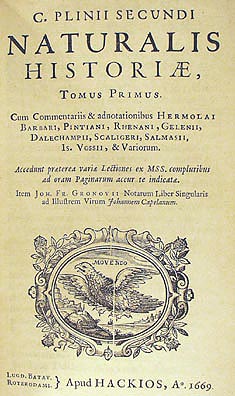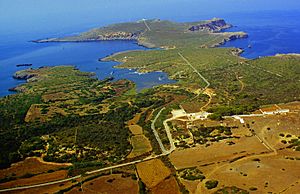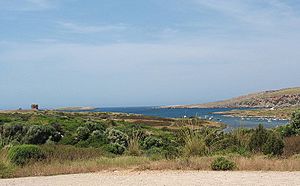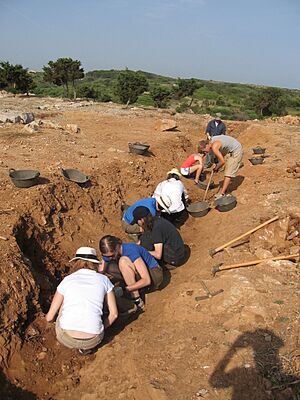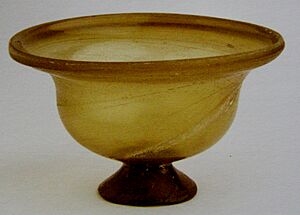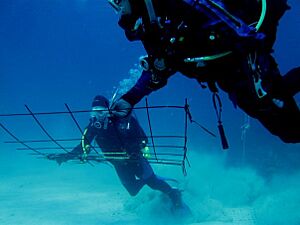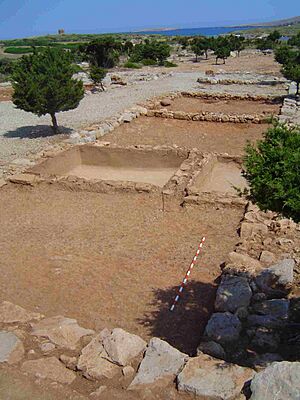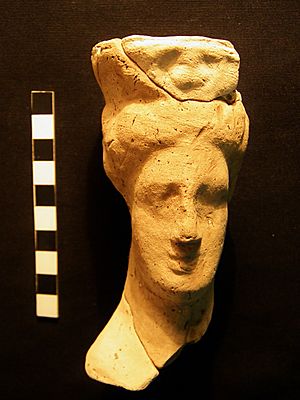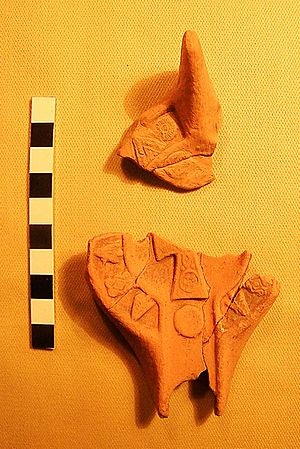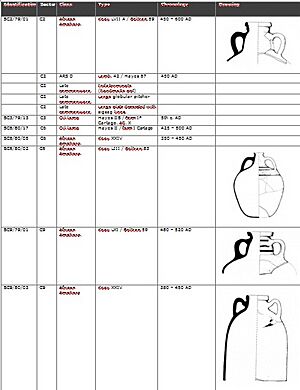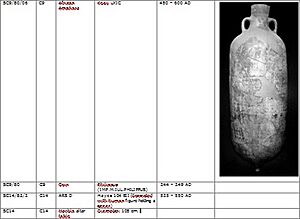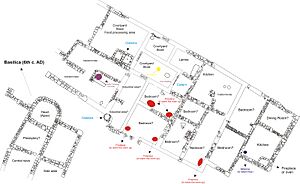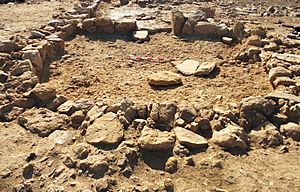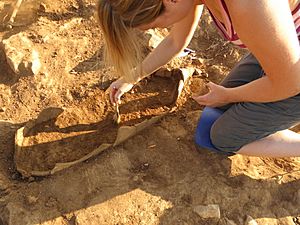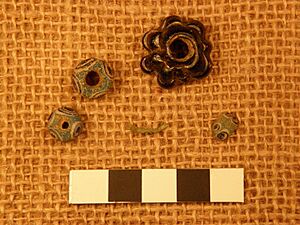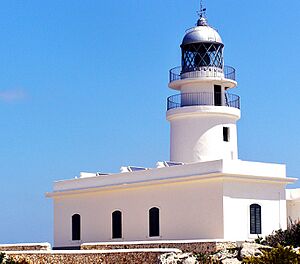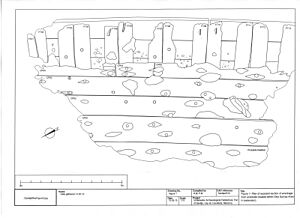Sanisera facts for kids
Sanisera was an ancient Roman city on the island of Menorca in Spain. It was first mentioned by a famous Roman writer named Pliny the Elder in his book Naturalis Historia way back in the 1st century BC.
Contents
Where was Sanisera?
The old city of Sanisera is found at a natural harbor called Sanitja. This spot is near Cavalleria Cape in Es Mercadal, on Menorca's rocky northern coast. Cavalleria Cape is a piece of land that sticks out into the sea. It has an 89-meter-high cliff with a lighthouse built in the 1800s.
The Port of Sanitja is a special place. It's protected from bad weather, especially strong northern winds. The port is about 800 meters long and 150-200 meters wide. Two small rocky islands at its entrance act like natural walls, calming the waves.
This natural protection made Sanitja a perfect place for people to settle. The Roman army even chose it as a military base when they conquered the Balearic Islands in 123 BC. Later, the British army, who controlled Menorca in the 1700s, also built a watchtower here. You can still see old bunkers from the Spanish Civil War too, showing how important this location has always been.
Today, the area is still untouched, which means archaeologists can keep exploring and finding more amazing things from the past!
How we learned about Sanisera
The first time Sanisera was written about was by Pliny the Elder in the 1st century AD. But finding its exact location was tricky!
Old maps from the 1500s to 1700s, like those by Abraham Ortelius and Petrus Bertius, showed different names for the area, like Zenaga or Senitja. These names were clues.
Writers and explorers from the 1700s onwards also helped. They described finding pottery pieces and old building parts scattered around the Port of Sanitja. This suggested a lost town was once there.
Local legends, like "Ses Vilotes," also talked about an old village. The fact that "Sanisera" and "Sanitja" sound similar made people think they were connected.
Then, in 1974, something exciting happened. People scuba diving started finding many Roman jars (amphorae) on the seabed. These jars dated from the 1st to the 4th centuries AD, proving that Roman ruins were indeed in this spot!
What does the name Sanisera mean?
The name "Sanisera" is a bit of a mystery. Experts haven't found other similar names in the Mediterranean region.
One idea is that the name has two parts: SANI and SERA. The "Sani-" part might be linked to an ancient Iberian language spoken in Spain. The "-sera" part could come from an old word meaning "to run" or "to flow." Since Sanisera is by a port and near a freshwater stream, this makes sense.
However, these are just ideas. More research is needed to fully understand where the name Sanisera came from.
Digging up the past: Archaeology
In the 1980s, archaeologists started digging on the western side of the port. They found the first signs of Sanisera, including a building that might have been a factory. This showed the city was used from about the 1st century BC to the 6th century AD, with its busiest time being until the 3rd century AD.
Later, the same team found another building with graves inside and outside. Years later, they realized it was an early Christian church called a basilica.
Archaeologists also learned that the Roman city of Sanisera was huge, covering about 60,000 square meters!
Since 1993, more land and underwater digs have been happening. To the east of the port, they found a Roman military camp from the time the Romans conquered the islands (123 BC). Now, they are also trying to map out the Roman city itself, which is on the west side of the port. They want to understand how it was built, what its different areas were used for, and how it changed over time.
What they found on land
After the early digs, new studies began in 1993. The site was so big that archaeologists divided it into smaller areas. They collected pottery from the surface to learn about the city's timeline.
The oldest pottery found was Punic amphorae. The newest materials were from North Africa, dating from 450-700 AD.
A lot of Roman pottery was found, especially Dressel 1 amphorae from the late Roman Republic. Many items also came from North Africa, showing strong trade links. These included fine pottery like ARS A and ARS D, and cooking pots. In fact, over half of all ceramics found were from North Africa!
Pottery from the Iberian Peninsula was also found, like amphorae from Tarraco and jars for preserving fish and oil from Southern Spain.
In 1994, a detailed map of the port was made. This helped archaeologists see where buildings might have been and where many artifacts were concentrated.
Underwater discoveries in Sanitja Port
The first archaeological finds in Sanitja came from under the sea in 1974. Scuba divers found many Roman amphorae (large jars) dating from the 1st to 4th centuries AD. This proved that Roman ruins were definitely in the area.
In 1979, the first underwater survey was done. They found amphorae with special stamps, and some later Roman amphorae. Experts also wrote about Roman anchors found in Menorca, including one from Sanitja weighing 26 kilograms.
In 1994, divers mapped more items, including an intact inkwell from South Gaul. They also found six anchors: four Roman and two possibly from the Middle Ages or later. In 1999, a well-preserved Roman glass cup was discovered.
In 2001, new technology like sonar was used. This helped locate thirteen groups of amphorae and five more anchors. This means a total of eleven anchors from different times have been found! These finds confirm that the Roman city was used for a long time, from the 2nd century BC to the 6th century AD, and that there was a lot of trade by sea.
Since 2006, underwater surveys happen regularly. Divers look for artifacts, map the seabed, and record everything they find. They've found more Roman amphorae, anchors, and even parts of modern shipwrecks. All these underwater remains tell us a lot about sea travel, trade, and how people moved around Menorca's northern coast throughout history.
Romans in Sanitja Port
Roman Military Camp (123 BC – 50 BC)
In 123 BC, a Roman general named Quintus Caecilius Metellus Balearicus led the conquest of the Balearic Islands. The islands were home to the Talayotic people. Rome decided to conquer them because pirates, possibly from the islands, were causing problems for trade in the Mediterranean Sea.
The Roman Senate sent Metellus to take control. He succeeded in two years. During this time, a military camp was set up at the Port of Sanitja. Metellus saw it as a very important spot. He built a military settlement with defensive towers to guard the port and the northern coast.
Even after the conquest, the camp was used until about 45 BC. Roman soldiers, including spearmen and infantry, lived and trained there. They also trained local slingers, who were famous for their skill. These slingers learned Roman military tactics and customs.
Because the camp was by the sea, food, wine, and other supplies arrived by ship. These ships carried amphorae filled with fish, wheat, wine, and olive oil from places like Ostia Antica. This constant flow of goods meant sailors and traders came to Sanitja. Some of them might have started to live near the camp permanently.
Growth of Sanisera City (1st century BC – 6th century AD?)
Roman Period (1st century BC - 5th century AD)
The small group of people who settled near the military camp slowly grew and became more organized. This became the city of Sanisera that Pliny mentioned. It grew into a stable place where people farmed, raised animals, and fished. At its largest, between the 1st and 3rd centuries AD, the city covered about 14 acres.
Sanisera's location in a great natural port was key to its growth. It became an important Roman port city, protected from bad weather. It likely played a big role in trade across the western Mediterranean. Pottery and other items found in the city and underwater show that goods came from many places outside Menorca.
After the Crisis of the Third Century, which affected the whole Roman Empire, Sanisera also began to shrink. Its population and size decreased. However, it didn't completely lose touch with other parts of the Mediterranean. Pottery from North Africa still arrived during this later period.
Late Antiquity
After the Roman Empire fell, Menorca was taken over by the Vandals in the 400s AD and then the Byzantines in the 500s AD. We don't know exactly how these cultures affected Sanitja, but materials from both periods have been found. This shows that trade continued to be busy at Sanitja Port during the 5th and 6th centuries AD. Pottery from North Africa and other places confirms these connections.
Archaeologists have found several important buildings from the late Roman Empire and Late Antiquity:
1. Building C (4th-6th centuries AD)
This building was dug up in the early 1980s. It had 8 rectangular rooms. Some were used for storage, and one might have had a press for making local wine. It was used between 450 and 524 AD. Inside, archaeologists found large African amphorae and a piece of a marble altar.
2. Early Christian Basilica
After Building C, the same team found another building with graves inside and outside. It had rectangular rooms and special floors. Four tombs were found inside, and 21 more were outside. All the graves were simple, with no special items, and the bodies were laid flat.
Years later, a curved wall (an apse) was uncovered, showing that this building was an early Christian basilica. It was likely built in the late 300s or early 400s AD, when Christianity became the main religion of the Roman Empire.
This church had a rectangular shape, divided into three long sections, with the main section ending in a curved apse. Finding such a religious building shows that Sanisera was still an important center, and that Christianity was widely accepted in Menorca during the 4th and 5th centuries.
3. Ecclesiastical Complex
Between 2008 and 2010, archaeologists found a whole church complex on the west side of Sanitja Port. This complex, probably from the 6th century AD, includes a basilica and a large building called Building 10. Building 10 had many rooms used for storage, sleeping, cooking, and more.
These types of complexes were common in Late Antiquity across the Mediterranean. They often included stables, places for baptisms, hospitals, and guest houses. Sometimes, they even had more than one church. This is true for Sanitja, as the basilica found in the 1980s is near these new structures. Future digs will help us understand how these buildings were connected.
The second basilica was found in 2010. It has a curved apse, a special area for the altar, and three long sections. Its walls are made of well-crafted stone blocks. Both basilicas show how important this area was in the 5th and 6th centuries AD.
The basilica has three building phases. The first phase shows parts of an older building that was reused. The second phase is when the basilica was built and used as a church, around the mid-5th century. The third phase shows that the building was later divided into smaller rooms for daily life, after it stopped being a church.
Archaeologists continue to find pottery from the 5th and 6th centuries, including items from Africa and Gaul. They also found personal items like glass beads, pendants, and belt buckles, similar to those found in nearby graves.
4. Necropolis 6
Between 2008 and 2011, a burial ground (necropolis) was excavated near Sanitja Port. It has 44 tombs, mostly rectangular pits lined with stone slabs. They are oriented east-west, which is typical for Christian burials.
The tombs often contained multiple burials, meaning they were reused. People were carefully moved aside to make room for new burials. Even if the tomb was disturbed, the skull usually remained at the west end, showing respect for the dead.
Archaeologists found at least 250 individuals in these tombs. Most babies and very young children were not buried here, which was common in ancient times. Life expectancy was low, between 31-40 years, with high death rates in childhood and adulthood. Common health issues included dental problems, joint disease, and infections, typical for rural populations.
In 2011, an interesting find was Tomb 42: an African amphora containing the remains of a one-year-old child. This type of burial was also common in Late Antiquity.
Some tombs contained personal items like earrings, rings, pendants, and beads. Most of these date from the 6th century AD. These finds help us understand the people who lived in or near Sanitja Port during that time.
Future digs will explore if the church complex and this burial ground were connected, as they are from the same time period.
Sanitja from the Middle Ages to today
It seems the city of Sanisera was mostly abandoned around the 6th century, though some people might have stayed.
What happened in the area between the 5th and 10th centuries is still unclear. There aren't many written records or archaeological finds from this period. The two basilicas might have been important for the people living there, perhaps even used by new settlers after the Roman Empire fell.
Muslim Occupation
Later, during the Muslim period, people lived in the port. Archaeologists found a small mosque built using old Roman stones. This mosque might have been part of a Muslim farm that hasn't been found yet. This shows that the port continued to be used for sailing and trade during the time of Al-Andalus.
The Islamic rule in Menorca lasted from 903 to 1286. The mosque in Sanitja is the first one found in the Balearic Islands. It was a rectangular room with a curved prayer niche (mihrab) pointing south.
Modern Period
S’Almadrava (18th and 19th centuries)
On the east side of Sanitja Port, there's a small white house called S’Almadrava. It was built in the late 1700s and was the first tuna fishing business in Menorca. It didn't last long, but later, in 1859, they tried again. That also failed, and since then, S'Almadrava has been used as a shelter for fishermen from Fornells.
British tower in Sanitja Port
Menorca's important location led the British army to occupy it for much of the 1700s and early 1800s. They ruled for about 70 years in three periods.
During their last occupation (1798–1802), the British built a watchtower at the entrance to Sanitja Port in 1800. It was one of eleven towers meant to stop enemy armies from landing. These towers had small groups of soldiers and swivel guns on top.
The Sanitja watchtower is round and has four levels. The basement collected rainwater, the ground floor stored supplies and weapons, and the third floor was for soldiers to sleep. The top floor had a swivel gun to watch over a large area.
Similar towers, called Martello towers, can be found in Ireland. Near the Sanitja tower, there are also two semicircular stone structures and a wall going into the sea. These might have been a dock and small defenses used by the British.
Cavalleria lighthouse and shipwrecks
In 1857, a lighthouse was built on Cavalleria Cape. It was needed because so many ships were wrecking on the northern coast. The lighthouse tower is 15 meters tall and stands 94 meters above sea level. It flashes two white lights every ten seconds and can be seen up to 26 nautical miles away.
Records show over 700 shipwrecks between the 1300s and 1800s. Many happened in the 1700s and 1800s, like the San Josef (1712), La Asunción (1821), and Bourgianen (1900). Two of these, La Asunción and Bourgianen, have been found recently.
The Bourgianen
In 2006, divers looked for the remains of the Bourgianen, an Italian schooner that sank in June 1900. They found parts of its wooden structure and other items like iron pieces. The ship was carrying beans and other goods from Catania to Barcelona when its rudder broke.
La Asunción
Many stone blocks were found scattered on the seabed. These are believed to be from the Sardinian ship La Asunción, which sank in 1821.
2009 discovery
In November 2009, a new shipwreck was found. It had fourteen wooden frames, four ceiling timbers, and two outer planks. These remains can tell us a lot about how ships were built and used in the past.
See also
 In Spanish: Sanisera para niños
In Spanish: Sanisera para niños


